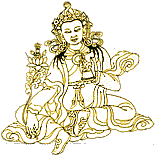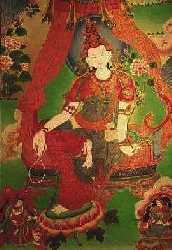Kalachakra means Time-Wheel, as "Kāla" is Sanskrit for Time and "Chakra"
(or Cakra) is Wheel in Sanskrit (In Tibetan his name is dus.'khor).
It is also translated as Time-Cycles. Much in this tradition revolves
around the concept of time and cycles: from the cycles of the planets,
to the cycles of our breath and the practice of controlling the most
subtle energies within one's body on the path to enlightenment. The
Kalachakra deity represents omniscience, as everything is under the
influence of time, he is time and therefore knows all. Similarly, the
wheel is beginningless and endless.
Among the five main Tibetan schools, the Kalachakra practice appears
most prominent in the Jonang tradition, although the practice is found
in all five schools. The Jonang
tradition is not well known due to historic reasons, but very
significant for Kalachakra practice. They established Kalachakra as
their main system for practice and have preserved a unique lineage
of the Kalachakra practice. The Dalai Lamas have had specific interest
in the Kalachakra practice, specifically the First, Second, Seventh,
Eighth, and the current Fourteenth Dalai Lama.
In Tibet, the Kalachakra
calendar and astrological system forms the main
building block to compose the Tibetan calendar.
The astrology in the Kalachakra is not unlike the Western system, where for example,
complicated calculations are required to determine e.g. the exact location of
the planets.
The phrase 'as it is outside, so it is within
the body' can be found in the Kalachakratantra to emphasize similarities and relations between
ourselves and the cosmos; this is the basis for astrology, but also for even more profound
connections and interdependence as taught in the Kalachakra literature.
"Time is the substance from which I am made.
Time is a river which carries me along, but I am the river;
It is a tiger that devours me, but I am the tiger;
It is a fire that consumes me,
but I am the fire."
Jorge Luis Borges |
KALACHAKRA
AND OTHER RELIGIOUS TRADITIONS
Among the other practices of the Highest Yoga Tantra (Anuttarayoga
in Skt.), the Kalachakra is in many aspects somewhat unusual. Many details
in this system deviate from the other Buddhist tantras, but they are
often also complementary to the other tantric systems. In fact, when
the Kalachakra was first introduced in the great Buddhist university
of Nalanda (India), these differences did cause some confusion. After
extensive study, the greatest masters agreed the system was genuinely
Buddhist, and the Kalachakra received its own place in the vast array
of Mahayana Buddhist teachings. In many aspects, the Kalachakra system
clearly shows its Buddhist core with concepts like renunciation, bodhicitta,
emptiness, enlightenment etc. being of major importance to the practice.
Kalachakra is also called the "clear" tantra, because its language is
unusually clear and straightforward as compared to most other Highest
Yoga Tantras.
As Vesna
Wallace notes in [5], the Kalachakratantra appears to combine aspects of several
different systems, including non-Buddhist systems of thought. For example, just
in the part of cosmology, aspects can be found of the Vaibhashika, Puranic, Samkhya,
Jaina, and of course the Buddhist Abidharma. Similarly, terminology of several
Hindu traditions can be found, as well as terms from Ayurvedic medicine.
"...the
Kalachakratantra adopts and redefines concepts characteristic of non-Buddhist
systems, it also incorporates non-Buddhist cosmological views without reinterpreting
them."
Vesna Wallace [5]
THE
MAIN KALACHAKRA TEXTS
 |
King Suchandra |
 |
Pundarika |
The Kalachakra teaching as taught by Shakyamuni Buddha is called the
Root Kalachakra Tantra, the Kalachakra
Mulatantra or Paramadibuddhatantra of 12,000 lines.
The Shambhala King Suchandra wrote a commentary called the Explanatory
Tantra in 60,000 lines. However, both these texts never reached
us.
Some parts of the original Paramadibuddhatantra have been preserved
by citation in other texts; mainly 200 verses in the Vimalaprabha,
and in the Sekoddesa, which circulated as an independent text
in early eleventh-century India and has traditionally been considered
to be a part of the Paramadibuddhatantra."[5].
According to tradition, the Shambhala King Manjushri-Yashas composed
the Abridged Kalachakra Tantra or Kalachakra Laghutantra (Skt.),
bsDus-rgyud (Tib.), it is also called 'the' Kalachakratantra
or Shri Kalachakra, as for us it fulfills the function of the
main tantric root text, although it is about one quarter the length
of the original Mulatantra. Together with the Stainless Light
Commentary, Vimalaprabha (Skt.), or Dri-med ‘od
(Tib.) written by Shambhala King Pundarika (see right), these two texts
form the basis of the Kalachakra practice.
A confusing
factor can be the frequent reference to 'Adibuddhatantra' by various authors
in history. It most likely refers to the original Root or Mulatantra,
but some scholars assume it refers to the Laghutanta.
All texts
follow the same sequence and are divided in five chapters. The first two chapters
concern the External (outer) and Internal (inner) Kalachakra, respectively. The
last three chapters present the so-called Alternative Cycles: the third chapter
discusses the Empowerment (initiation), the fourth the Generation Stage and the
fifth the Completion Stage and the attainment of enlightenment. All later commentaries
also follow this five-part structure.
OUTER,
INNER AND ALTERNATIVE KALACHAKRA
Outer Kalachakra refers to
the outer world which is the vessel supporting the living beings. It is compounded
by the six elements of earth, water, fire, air, space and wisdom; and all objects
of smell, sight, taste, touch, sound and Dharma. Another division follows the
cosmic buildup of the universe; the center made up by Mt. Meru, surrounded by
the four continents and the eight subcontinents. Around its' peak circle the planets
of our solar system, the moon, sun, stars and so forth. This system is dictated
by time cycles of years, months and days; also described as "the procession of
the external solar and lunar days."
Inner Kalachakra consists of
the body and mind of living beings, the psychophysical aggregates, the sensory
and psychic capacities so forth. This includes the six types of living beings
(gods, demigods, humans, animals, hungry ghosts and hell-beings), the six energy
centers (chakras) of the body, the ten vital energies, the energy channels, the
eight drops that carry the instincts of the two obscurations, and so forth. Inner
Kalachakra deals with the astrological relationships of the internal energies,
chakras, channels and drops to mental and emotional states, physical organs, and
transformation processes. The basic theory is that on the body's subtle energies
normally move in synchronicity with the cycles of the planets. This movement of
planetary energies within the body is the subject of the astrology of the Internal
Kalachakra.
In other words, Inner and Outer Kalachakra include all the living
beings and the external world in an astrological relation to the living beings.
The relation is similar to the Greek expression "as above, so below".
Alternative (or 'Other') Kalachakra describes the spiritual method
leading to enlightenment in the form of Kalachakra. It describes the initiation,
the Generation Stage and Completion Stage Yogas. These two Yoga stages are the methods
that have the power to purify the Outer and Inner Kalachakras (sentient beings and
the universe).
Outer and Inner Kalachakras are the bases to be purified,
whereas Alternative Kalachakra refers to the yogic practices that effect this
purification and produce the three purified results.
"There
exists an archetypal pattern behind both {inner and outer Kalachakra}, and it
is this pattern which is the "other", shown in the Kalacakra mandala. .... Through
the practice of the Kalacakra sadhana, the practitioner who is the microcosm,
can become an instrument for manifesting in the world, which is the macrocosm,
the cosmic order or universal harmony from the blueprint which is the Kalacakra
mandala. ... the whole cosmos is a single living entity, and all that makes it
up is interconnected. This single living entity is depicted as the Purusa, or
"cosmic Person", in the Vedic teachings, and as the Adi-Buddha, or "cosmic Buddha"
in the Kalacakra teachings. ... A Buddha is described as one who has the thirty-two
major marks and the eighty minor marks of a Maha Purusa, or "Great Person", and
in Kalacakra this is applied to the Adi-Buddha, which represents the cosmos."
David Reigle [4]
The Kalachakratantra also takes a firm
stand on social issues, specifically against the Indian caste system.
As
Vesna Wallace writes in [5],
"It regards social discrimination
and the interpretation of scriptures that support such discrimination as detrimental
to both the socio-political, material, and spiritual welfare of society and to
the psychological and physical well-being of the individual."
BIBLIOGRAPHY
[1]: Taking the Kalachakra
Initiation, Alexander Berzin, Snow Lion, 1997 ISBN 1-55939-084-0
[2]:
Commentary given by Kirti Tsenshab Rinpoche December 1989, Bodh Gaya India
[3]: The Wheel of Time, the Kalachakra
in context. Geshe Lhundub Sopa et al, Snow Lion, 1985
[4]: Kalacakra
Sadhana and Social Responsibility, David Reigle, Spirit of the Sun Publications
1996.
[5]: The Inner Kalacakratantra, Vesna
Wallace, Oxford University press 2001.
[6]: The
Practice of Kalachakra, Glenn H. Mullin